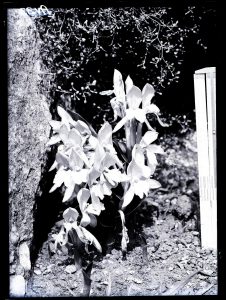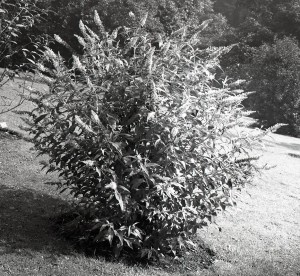As a fan of eminent plant collector George Forrest (1873-1932), I’d long known that two of his plant introductions had been named after former RBGE gardeners killed in the First World War; Roscoea humeana, named for Private David Hume and Buddleia fallowiana for Sergeant George Fallow. What I found curious was that Hume’s name appears on RBGE’s war memorial, now situated in the foyer of the Science Buildings on Inverleith Row, despite him having given up horticulture in 1906, whereas Fallow’s name doesn’t appear at all. Why? What are their stories?
David Hume
David Hume was born on the 12th September 1888 at 30 Colville Place, Edinburgh to Peter and Davina Hume. His mother unfortunately died of bronchial asthma when he was just 12 years old, but his father remarried at the end of 1905, this time to their landlady, Alice Rintoul.
By this time, David was working as a probationer gardener at RBGE, having joined as a ‘boy’ in the Glass Department at the age of 15 on the 11th April 1904. He’d been working as an apprentice gardener for over a year before this. The idea of a probationer gardener was that you worked at RBGE for three years for minimum wage, or close to it, but in the evenings you could attend classes, sit exams, and improve your c.v. and future job prospects. David, however, did not exactly excel in the classroom and the exams he did sit received low marks. He came to us with no references and he apparently left with none, giving up his probation early to enlist in the Royal Scots Regiment on the 22nd September 1906. Presumably it was felt a career in the army was better suited to him.
The Regius Keeper (Director) of RBGE during the First World War was Isaac Bayley Balfour. He came up with the idea of naming new plants in honour of members of his staff who fell during the Great War, but in the end, it seems only four received this honour, Hume being one of them – what made him stand out? There must have been something unique about him. And I was still confused about why his name was on the war memorial when he had left RBGE. That question was eventually answered quite easily on inspection of RBGE’s Roll of Honour – a list of all the men who had enlisted during the War. On it was David Hume, listed as a Labourer who joined the Garden on the 22 April 1914 – at this time, when one enlisted in the Regular Army, it was typical to serve full time for seven years and then serve a five year period on reserve. Hume would have presumably begun his reserve period at the end of 1913 and eventually returned to us – so that question was answered. But what of the other?
When war was declared on the 4th August 1914, David Hume, being a trained soldier on reserve was quickly mobilised to the 2nd Royal Scots and would have been part of the first British Expeditionary Forces sent across the Channel into Belgium who initially engaged with the enemy army at the Battle of Mons. The first British casualty of the war is generally recognised to be Private John Parr, killed on 21 August 1914. Private David Hume is listed in the footnote to the description of Roscoea humeana as having “[fallen] in action during the retreat from Mons on 26th August 1914”, during the first week of fighting and only 20 days after his mobilisation. This must have been tremendously shocking for those back in Edinburgh and I’m sure lead to Hume being commemorated and immortalised in a plant name.
George Fallow
George Fallow’s story is perhaps less mysterious, but no less tragic. The reason for his name not being included on the memorial is a simple one – he had left the staff of RBGE during the summer of 1914. The reason for this was recalled by Henry (Harry) Howden Bryce in the RBGE Guild News Sheet, March 1980: “Some of the ‘lads’ joined the Territorials. The ‘Terriers’ were quite an attraction during this time. Apart from the drills and parades there was the big attraction of the Summer Camp”… “In July 1914 the Prof [Isaac Bayley Balfour] supervised the arranging of a demonstration of exhibits in the Laboratory… The whole layout was like a cross-section through the field of Botany.” All this was for a surprise oral examination for Balfour the following evening – the probationers would have to study the exhibits in order to talk about any subject Balfour asked them to. After the exam, “the Prof then asked if anyone would volunteer to talk on any of the subjects… only one stood up and that was George Fallow. The following morning George was called up to the Prof’s office.” Balfour had been asked to recommend someone for the post of Subinspector in the Horticulture Branch of the Board of Agriculture, London. Fallow was recommended and selected for the position. “Now, George was a member of the Territorials and he decided to go to camp with his fellow students, then after camp he would proceed to his new appointment. Alas, the ‘best laid schemes’…” Fallow was still at camp on the 4th August when war was declared. The ‘Terriers’ were immediately put on active service training rather than return to their jobs.
As Fallow had left his post just prior to the outbreak of war he does not feature on the RBGE memorial nor the Roll of Honour, but the footnote to the description of Buddleia fallowiana states: “The specific name is given to keep in memory Sergeant George Fallow, 5th Batt. The Royal Scots, a former gardener on the staff of the Royal Botanic Gardens, Edinburgh, who died 19th August 1915, in Egypt, of wounds received in action at Gallipoli.”
.
Naming this plant after Fallow has certainly kept him in memory, but it also serves as a reminder to us that there are undoubtedly many, many more men, a good example being probationer gardeners, here for periods of three years before moving on, who have been closely associated with RBGE, and have contributed greatly to the organisation, who enlisted in the Forces but are un-named in our records. I only wish it were possible to add these names to the Roll now.



2 Comments
2 Pingbacks